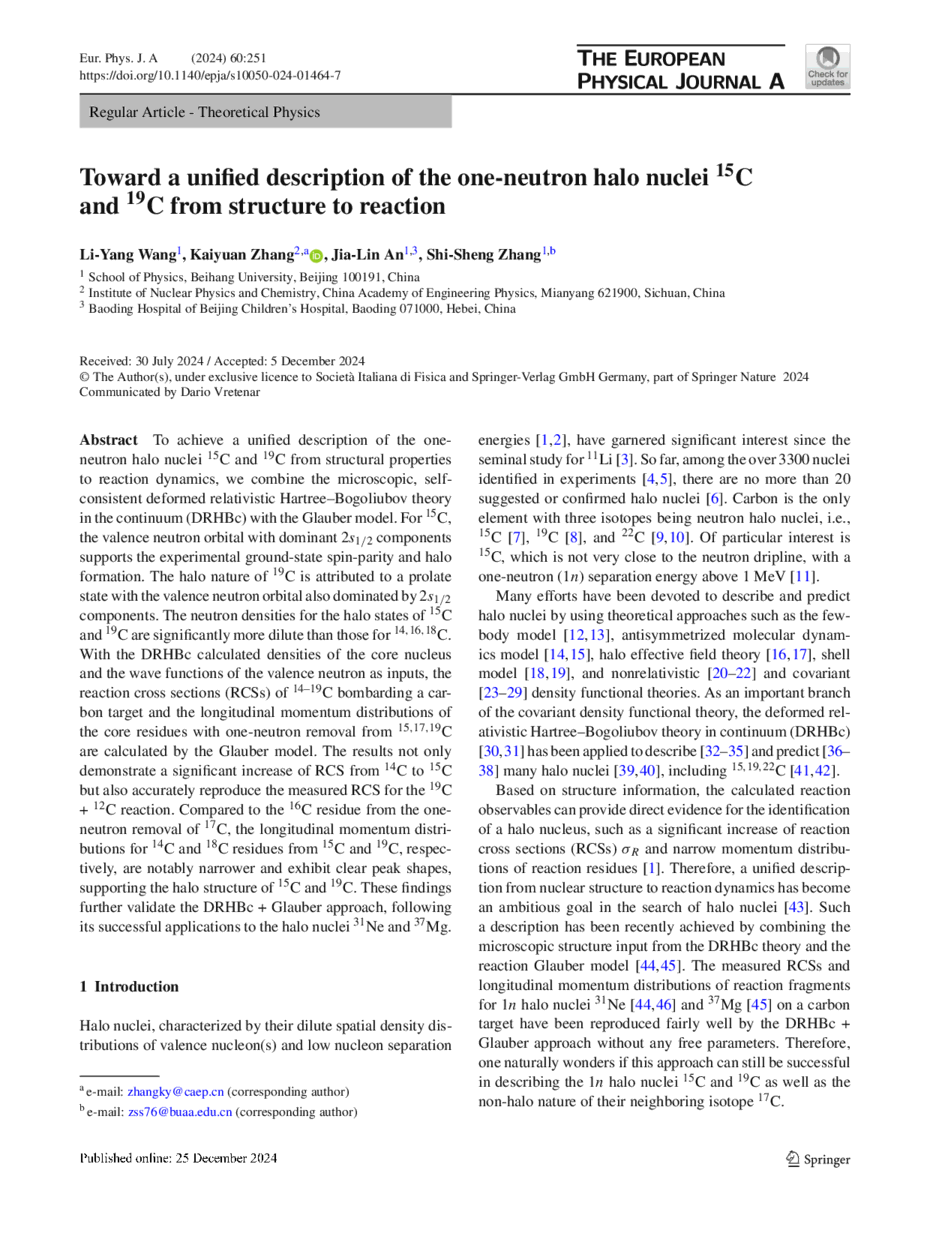https://doi.org/10.1140/epja/s10050-024-01464-7
Regular Article - Theoretical Physics
Toward a unified description of the one-neutron halo nuclei  C and
C and  C from structure to reaction
C from structure to reaction
1
School of Physics, Beihang University, 100191, Beijing, China
2
Institute of Nuclear Physics and Chemistry, China Academy of Engineering Physics, 621900, Mianyang, Sichuan, China
3
Baoding Hospital of Beijing Children’s Hospital, 071000, Baoding, Hebei, China
a
zhangky@caep.cn
b
zss76@buaa.edu.cn
Received:
30
July
2024
Accepted:
5
December
2024
Published online:
25
December
2024
To achieve a unified description of the one-neutron halo nuclei  C and
C and  C from structural properties to reaction dynamics, we combine the microscopic, self-consistent deformed relativistic Hartree–Bogoliubov theory in the continuum (DRHBc) with the Glauber model. For
C from structural properties to reaction dynamics, we combine the microscopic, self-consistent deformed relativistic Hartree–Bogoliubov theory in the continuum (DRHBc) with the Glauber model. For  C, the valence neutron orbital with dominant
C, the valence neutron orbital with dominant  components supports the experimental ground-state spin-parity and halo formation. The halo nature of
components supports the experimental ground-state spin-parity and halo formation. The halo nature of  C is attributed to a prolate state with the valence neutron orbital also dominated by
C is attributed to a prolate state with the valence neutron orbital also dominated by  components. The neutron densities for the halo states of
components. The neutron densities for the halo states of  C and
C and  C are significantly more dilute than those for
C are significantly more dilute than those for  C. With the DRHBc calculated densities of the core nucleus and the wave functions of the valence neutron as inputs, the reaction cross sections (RCSs) of
C. With the DRHBc calculated densities of the core nucleus and the wave functions of the valence neutron as inputs, the reaction cross sections (RCSs) of  C bombarding a carbon target and the longitudinal momentum distributions of the core residues with one-neutron removal from
C bombarding a carbon target and the longitudinal momentum distributions of the core residues with one-neutron removal from  C are calculated by the Glauber model. The results not only demonstrate a significant increase of RCS from
C are calculated by the Glauber model. The results not only demonstrate a significant increase of RCS from  C to
C to  C but also accurately reproduce the measured RCS for the
C but also accurately reproduce the measured RCS for the  C +
C +  C reaction. Compared to the
C reaction. Compared to the  C residue from the one-neutron removal of
C residue from the one-neutron removal of  C, the longitudinal momentum distributions for
C, the longitudinal momentum distributions for  C and
C and  C residues from
C residues from  C and
C and  C, respectively, are notably narrower and exhibit clear peak shapes, supporting the halo structure of
C, respectively, are notably narrower and exhibit clear peak shapes, supporting the halo structure of  C and
C and  C. These findings further validate the DRHBc + Glauber approach, following its successful applications to the halo nuclei
C. These findings further validate the DRHBc + Glauber approach, following its successful applications to the halo nuclei  Ne and
Ne and  Mg.
Mg.
Copyright comment Springer Nature or its licensor (e.g. a society or other partner) holds exclusive rights to this article under a publishing agreement with the author(s) or other rightsholder(s); author self-archiving of the accepted manuscript version of this article is solely governed by the terms of such publishing agreement and applicable law.
© The Author(s), under exclusive licence to Società Italiana di Fisica and Springer-Verlag GmbH Germany, part of Springer Nature 2024
Springer Nature or its licensor (e.g. a society or other partner) holds exclusive rights to this article under a publishing agreement with the author(s) or other rightsholder(s); author self-archiving of the accepted manuscript version of this article is solely governed by the terms of such publishing agreement and applicable law.






